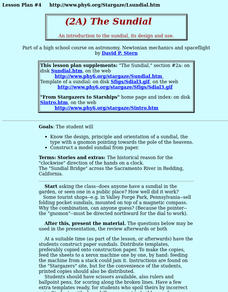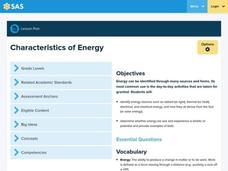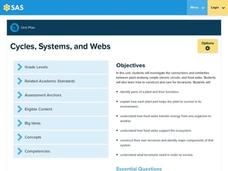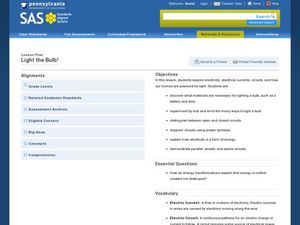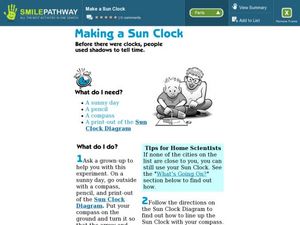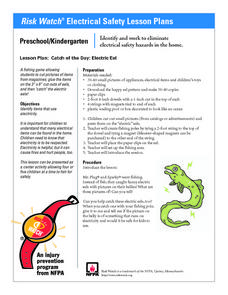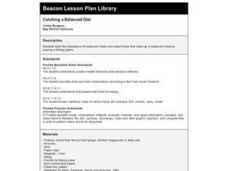Curated OER
The Sundial
Students explain the design, principle and orientation of a sundial, the type with a gnomon pointing towards the pole of the heavens. They construct a model sundial from paper.
Curated OER
Origins: Earth Is Born
Students develop a timeline of all the major events involved in the formation of the Earth and the emergence of humans. In groups, they focus on a specific topic by watching a PBS program and taking notes. After the video, they list...
Curated OER
Show Me the Way To Go Home
Students place a pencil perpendicular to the ground and trace its shadow between 11:30 AM and 12:30 PM. They measure the length of the shadow, periodically over several hours, in either English or Metric units. Using the data, they find...
Curated OER
Building a Terrarium System
Learners create their own terrariums. In this ecological model lesson, students create terrariums using soil, seeds, pebbles, and two liter bottles. Learners compare the elements of a terrarium to a food web.
Curated OER
Characteristics of Energy
Fourth graders view a video and create a KWL to identify energy sources. In this energy sources lesson, 4th graders explore the meaning of energy, kinetic energy, potential energy, thermal energy, radiant energy, and electrical energy....
Pennsylvania Department of Education
Cycles, Systems, and Webs
Fourth graders review the parts of the plant and their functions. In this plant lesson plan, 4th graders recognize that plants must transfer energy to make food. Students understand the interdependence of organisms in an ecosystem.
Pennsylvania Department of Education
Light the Bulb!
Third graders investigate electrical circuits and how light bulbs are powered. In this electricity and power activity, 3rd graders study the vocabulary necessary which includes the different types of circuits, electrical currents, and...
Curated OER
Charge and Electricity
In this charge and electricity worksheet, students read about electric charges and how they are created in atoms. They also read about the unit of charge, called the Coulomb, conductors, and insulators. Emerging electricians match 11...
It's About Time
AC and DC Currents
An informative physics lesson includes two teacher demonstrations, one on AC currents and the other on DC currents, allowing pupils to take notes while watching. The resource includes questions to assign as homework or during class...
Curated OER
Making a Sun Clock
In this clock construction lesson, students use a pencil, compass, and sun clock diagram to construct a homemade sun clock. A very interesting lesson on combining images with text.
Florida Center for Reading Research
Phonics: High-Frequency Words, Word Fishing
To practice reading high-frequency words fluently, learners play a fishing game at a learning center. They take turns fishing; each fish contains a single high-frequency word. To keep the fish they caught, they must be able to read the...
PHET
Where to See an Aurora
Where can you see an aurora in North America? After completing an astronomy activity, scholars can locate the exact coordinates. Pupils plot points of the inner and outer ring of the auroral oval and answer questions based on their...
Curated OER
Catch of the Day: Electric Eel
Students identify and work to eliminate electrical safety hazards in the home. They identify items that use electricity. Students use a fishing game that allows students to cut pictures of items from magazine; glue the items on the 3" x...
Curated OER
Fish Math
Students recognize things that are the same and things that are different. They use shape, size, numbers and color, for recognition. They make fish with different shapes/colors on them and 'fish' for the kind of fish that displays the...
K12 Reader
Where On Earth Are You?
What do we use to determine the exact locations on the earth? Your kids can learn all about compass roses and latitude and longitude. Test understanding with the five reading comprehension questions included on the page.
Curated OER
Observation and Inference
Assess your young scientists' understanding of the difference between observation and inference with this 20-question multiple choice quiz. It reviews a variety of physics and astronomy concepts, such as solar eclipses and sunspots, the...
Curated OER
Navigation Across the Seas
Students examine nautical navigation and discover the differences between nautical charts and other types of maps or charts. Students practice setting a course, taking a bearing, and dead reckoning. This gives students an example of...
Curated OER
Plant Cycles
Young scholars identify plants parts and their functions. In this plant cycle lesson, students examine parts of plants and how the parts help them survive in its environment. Young scholars use graphic organizers, the internet, books...
Curated OER
Light the Bulb
Students explore electricity. In this power experiment lesson, students determine what is required for lighting a bulb. Students develop an understanding of open and closed circuits, and how energy is formed
Curated OER
Characteristics of Energy
Students explore Earth science by completing energy worksheets in class. In this energy forms lesson plan, students identify and define a list of energy vocabulary terms and a K-W-L chart. Students view a matter video clip in class and...
Pennsylvania Department of Education
Energy in Motion
Fifth graders explore energy transfer. In this thermal energy lesson, 5th graders stretch rubber bands several times and estimate the band's temperature change. Students identify this action as an example of thermal energy. Students...
Curated OER
So Many Inventions!
Students read two books about Chinese inventions such as the compass, kite or dominoes. They bring in examples of Chinese inventions from home and create a class gallery. They make a compass in class.
Beacon Learning Center
Catching a Balanced Diet
First graders explore the importance of balanced meals. They play a fishing game to help them select foods to make up a balanced meal.
Curated OER
Compass Building Instructions
Students build their own compass following a given procedure. For this technology lesson, students explain how a compass is used in navigation. They trace the history of its development.


